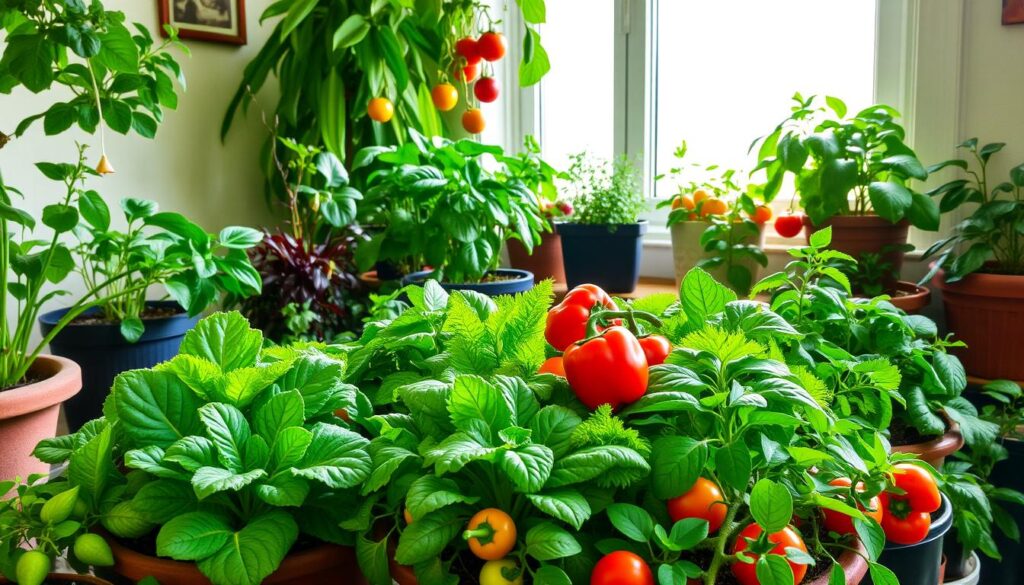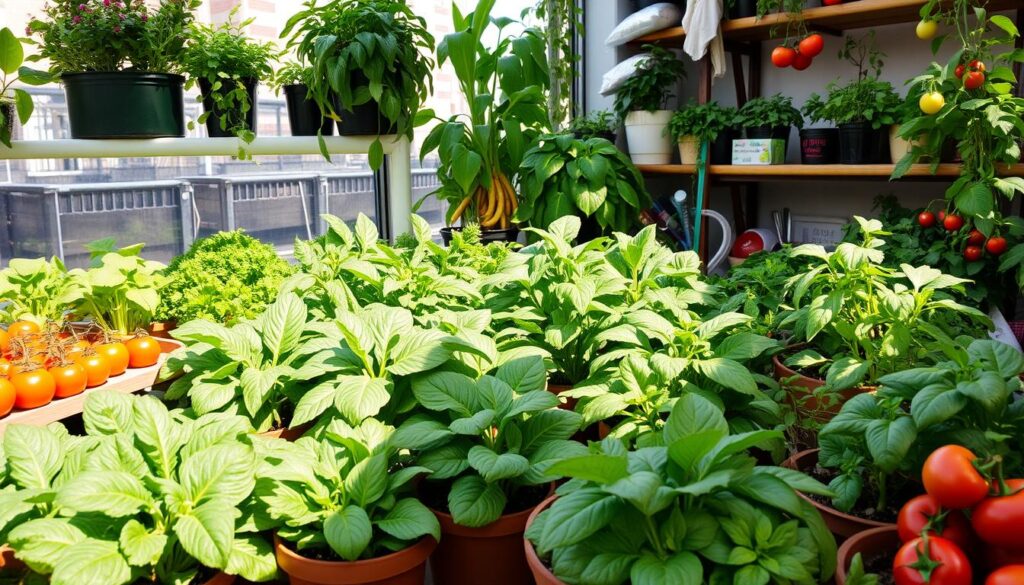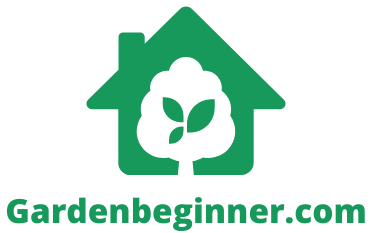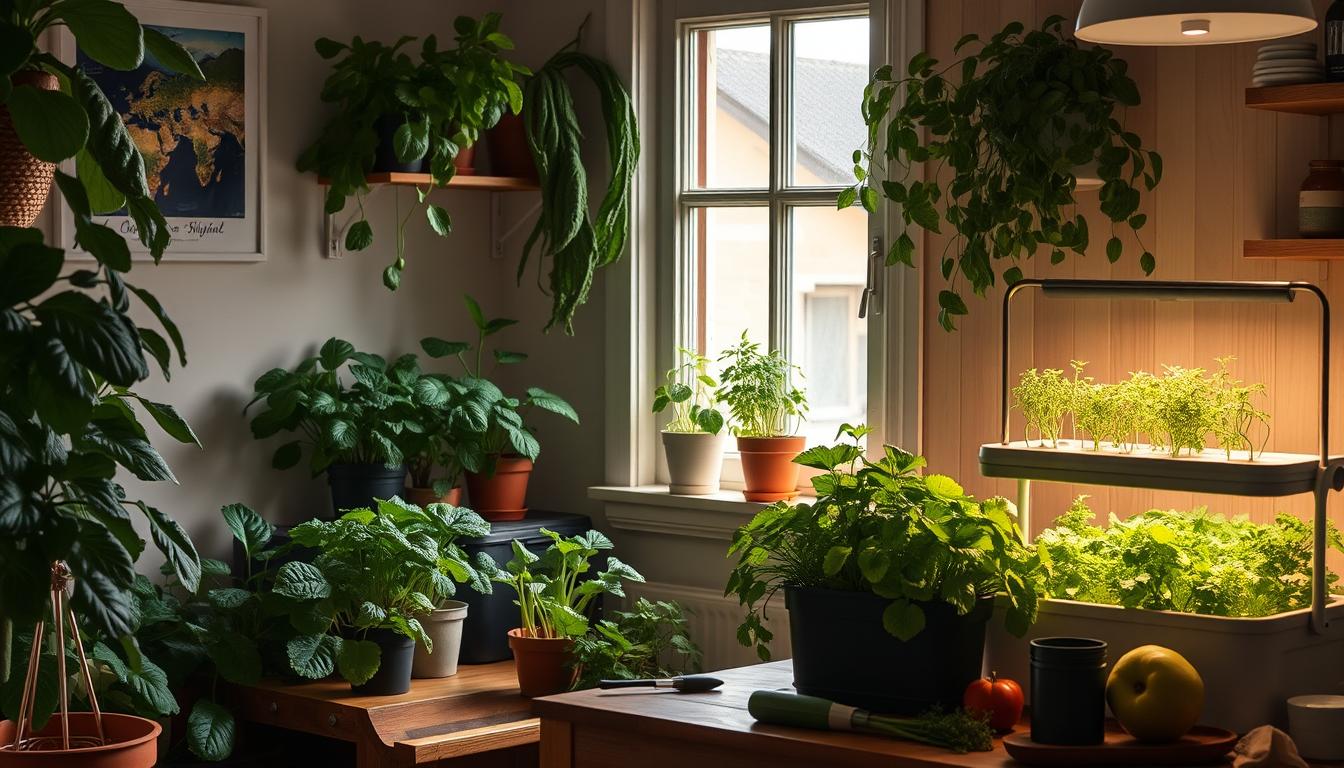In this guide, I’ll share expert tips to help you grow a thriving indoor garden. You can enjoy fresh produce all year, even with limited space. Discover how to create a successful, bountiful indoor garden.
Key Takeaways
- Explore the possibilities of indoor vegetable gardening for year-round cultivation.
- Understand the benefits of growing your own fresh produce at home.
- Learn how to set up a productive indoor vegetable garden in any space.
- Discover the best vegetable varieties for thriving in indoor environments.
- Master the art of indoor lighting and climate control for optimal plant growth.
Introduction: Unleashing the Possibilities of Indoor Gardening
In the busy city, where space is tight, growing your own veggies might seem far-fetched. But indoor gardening has opened up new doors. Now, city folks and apartment dwellers can grow their own veggies, no matter the weather.
Why Grow Veggies Indoors?
There are many good reasons to grow veggies indoors. First, it’s super convenient and controlled. You can make a perfect growing spot. This way, you can grow food year-round, without worrying about the weather.
Benefits of Year-Round Cultivation
- Enjoy the freshness and flavor of homegrown produce all year long.
- Contribute to a more sustainable and urban agriculture lifestyle.
- Reduce your carbon footprint by limiting the need for long-distance food transportation.
- Discover a newfound sense of self-reliance and fulfillment in growing your own food.
Indoor gardening is for everyone, whether you’re new or experienced. It lets you turn your home into a garden full of fresh food. This way, you can enjoy the benefits of growing veggies all year.
Setting Up Your Indoor Vegetable Garden
Starting an indoor vegetable garden is fun and rewarding. First, think about where you’ll set up your garden. This includes picking the right spot and making sure the environment is just right. These steps are key to a successful indoor garden.
Selecting the Perfect Spot
Finding the right spot for your garden is important. Look for a place that gets lots of sunlight. If sunlight is scarce, use artificial lights to help your plants grow.
Also, think about how much space you have. Choose a spot that fits your plants and any containers or raised beds you plan to use.
Creating an Indoor Grow Space
Building a special area for your garden can help a lot. You might set up shelves, use grow tents, or pick a room for your garden. Make sure it’s well-ventilated and keeps a steady temperature for your plants.
Mastering the Ideal Environment
Indoor gardening needs the right mix of things like temperature, humidity, and air flow. Keep the temperature right for your plants and use fans or dehumidifiers to control humidity. Good air flow helps prevent pests and diseases.
By setting up your garden well, you’ll give your plants the best chance to grow. With the right spot, space, and controls, you’ll enjoy fresh produce all year.
Choosing the Right Vegetables for Indoor Growing
Not all plants are good for indoor gardens. To get the most from your garden, pick varieties that do well in small spaces. Here are some top picks for your indoor garden.
Compact Varieties for Limited Spaces
Space is key when growing veggies indoors. Luckily, there are many compact vegetable varieties perfect for indoor growing. Some great options include:
- Dwarf tomatoes
- Mini bell peppers
- Radishes
- Carrots
- Leafy greens like lettuce and spinach
These space-saving indoor gardening choices let you grow a lot without taking up too much room.
Nutritional Powerhouses to Cultivate
Size isn’t the only thing to think about. Choose nutrient-dense indoor crops that are full of vitamins and minerals. Some of the best vegetables for indoor growing are:
- Kale
- Swiss chard
- Microgreens
- Cherry tomatoes
- Herbs like basil, mint, and parsley
By picking these high-yield indoor plants, your garden will be a source of healthy, homegrown food all year.

“The joy of growing your own food, even in the smallest of spaces, is unparalleled. With the right vegetable varieties, you can create a thriving indoor oasis that nourishes both body and soul.”
Mastering the Art of Indoor Lighting
Creating a thriving indoor garden is more than just the right soil and containers. Proper lighting is key for your plants to grow well. Knowing the light needs of your plants and using artificial lighting are crucial steps.
Understanding Light Requirements
Vegetables need different amounts of light. Leafy greens and herbs do well in low light. On the other hand, tomatoes and peppers need more intense indoor vegetable lighting requirements. Knowing what your plants need is the first step to a great indoor garden.
Artificial Lighting Solutions
When sunlight is hard to get, artificial lighting for indoor gardens is a must. LED grow lights are a top choice because they save energy and can be adjusted. By placing and adjusting these LED grow lights right, you can give your plants the best light for growth.
“Proper lighting is the foundation of a successful indoor vegetable garden. With the right setup, you can unlock the full potential of your crops and enjoy a bountiful harvest year-round.”
By knowing your plants’ light needs and using good artificial lighting solutions, you can master indoor lighting. This will help you grow a thriving garden that gives you fresh produce all year.
How to Grow Vegetables Indoors Year-Round
To grow vegetables indoors all year, you need a smart plan. I’ve learned many techniques to help you succeed. These will guide you in creating a garden that never stops giving.
Knowing what plants need is crucial. Some plants love the indoor life, while others don’t. Choose the right ones for your space to enjoy a constant harvest.
Seasonal changes also play a big role. You’ll need to adjust your garden to match the seasons. This means changing when you plant, how much light you give, and more. Stay ahead of these changes to keep your garden thriving.
| Technique | Description |
|---|---|
| Succession Planting | Plant seeds at different times to have a steady supply. You can plant new seeds every few weeks or move seedlings around. |
| Crop Rotation | Move plants around to avoid soil problems. This keeps the soil healthy and prevents diseases. |
| Microclimate Management | Change the light, temperature, and humidity to match what your plants need. This creates the best conditions for growth all year. |
Using these methods will help you keep your indoor garden full of fresh produce. You’ll enjoy a constant supply of homegrown veggies.
“The true secret of happiness lies in taking a genuine interest in all the details of daily life.” – William Morris
Success in indoor gardening comes from being flexible and attentive. With the right approach, you can have a garden that’s always fruitful, no matter the season.
Soil and Containers: The Foundation of Your Garden
Growing a thriving indoor vegetable garden starts with the right soil and containers. Choosing the right potting mix for indoor gardening and indoor growing containers is key for your plants’ success.
Choosing the Right Potting Mix
Not all indoor vegetable garden soil is the same. Find a high-quality, well-draining mix made for container gardening for vegetables. These mixes are light, full of nutrients, and meet indoor plants’ needs.
- Avoid regular garden soil, as it can compact and cause poor drainage in containers.
- Choose a mix with organic matter like compost or peat moss for essential nutrients.
- Add perlite or vermiculite to improve aeration and water retention.
Selecting Appropriate Containers
The size and type of containers greatly affect your indoor garden’s growth. Choose space-efficient indoor growing containers that offer enough room for roots without using too much space.
| Container Type | Recommended Vegetables | Ideal Container Size |
|---|---|---|
| Raised Beds | Tomatoes, peppers, cucumbers | 12-24 inches deep |
| Grow Bags | Potatoes, carrots, radishes | 5-15 gallons |
| Window Boxes | Lettuce, herbs, cherry tomatoes | 6-12 inches deep |
By picking the right indoor vegetable garden soil and indoor growing containers, you’ll create the best foundation for your garden to flourish all year.

Watering and Fertilizing: Keeping Your Plants Thriving
Watering and fertilizing are key for your indoor garden’s health. As an experienced gardener, I’ve found that managing water and nutrients well is crucial. It makes a big difference in growing a successful indoor harvest.
Mastering Efficient Watering Techniques
Watering your indoor garden needs care. Too much water can cause root rot, while too little can slow growth. To get it right, check the soil moisture often and adjust your watering schedule.
- Use your finger to test the soil depth and ensure it’s moist but not waterlogged.
- Water your plants when the top inch of soil becomes dry, being careful not to let the soil dry out completely.
- Consider using a self-watering container system to maintain consistent moisture levels and minimize the risk of over or under-watering.
Crafting a Balanced Fertilization Regimen
Right nutrients are vital for your indoor crops’ health. A balanced fertilization schedule helps your plants grow well and boosts your gardening efforts.
- Choose a quality liquid or water-soluble fertilizer formulated for indoor vegetable growing.
- Apply the fertilizer at the recommended dosage and frequency, typically every two to four weeks.
- Monitor your plants’ growth and adjust the fertilizer amount or frequency as needed to maintain optimal nutrient levels.
| Nutrient | Function | Optimum Level |
|---|---|---|
| Nitrogen (N) | Promotes foliage growth | 15-30 ppm |
| Phosphorus (P) | Supports root development and flowering | 10-20 ppm |
| Potassium (K) | Enhances overall plant health and disease resistance | 20-40 ppm |
By learning to water indoor vegetable gardens and fertilize indoor crops well, you can keep your plants healthy. With practice and attention, your garden will flourish and give you a rich harvest all year.
Pest and Disease Management for Indoor Gardens
Keeping your indoor garden healthy means watching out for pests and diseases. Spotting problems early and using green solutions helps protect your plants. This way, you can enjoy a full harvest all year.
Identifying Common Pests and Diseases
Indoor gardens face many pests and diseases, like aphids and powdery mildew. Look closely at your plants for signs of trouble. Watch for discolored leaves, wilting, or bugs. Some big threats include:
- Aphids: Small, sap-sucking insects that can quickly multiply and damage plants
- Spider mites: Tiny arachnids that spin fine webbing and feed on plant juices
- Fungus gnats: Small flies that thrive in moist soil and can spread disease
- Powdery mildew: A fungal disease that forms a white, powdery coating on leaves
- Bacterial leaf spot: A disease that causes discolored, spotted leaves
Organic and Eco-Friendly Solutions
For pest control and disease prevention, choose natural methods. Stay away from harsh chemicals that can harm your plants and health. Here are some green ways to manage pests and diseases:
- Use beneficial insects, such as ladybugs or lacewings, to prey on garden pests
- Apply neem oil or insecticidal soap to target specific infestations
- Introduce diatomaceous earth to the soil to deter crawling insects
- Maintain good air circulation and moisture levels to prevent fungal diseases
- Practice proper sanitation by regularly cleaning tools and removing infected plant matter
By using these organic and eco-friendly methods, you can keep your garden healthy. This ensures a steady supply of fresh, homegrown produce.
Conclusion: Embracing the Joy of Homegrown Produce
Starting your indoor vegetable garden is a journey filled with joy and satisfaction. You’ll enjoy fresh, nutritious produce all year round. This not only brings amazing flavors to your meals but also connects you deeply with your food.
Homegrown vegetables offer more than just great taste. They help you live more sustainably by reducing waste and supporting eco-friendly farming. Growing your own food gives you peace of mind, knowing where your meals come from.
Whether you’re new to gardening or have experience, indoor vegetable gardening opens up new possibilities. It brings self-sufficiency and the joy of enjoying what you grow. Start this journey and find the happiness in growing your own food at home.



Leave a Reply